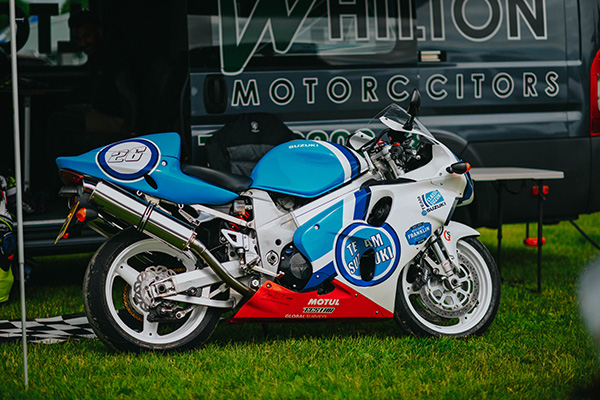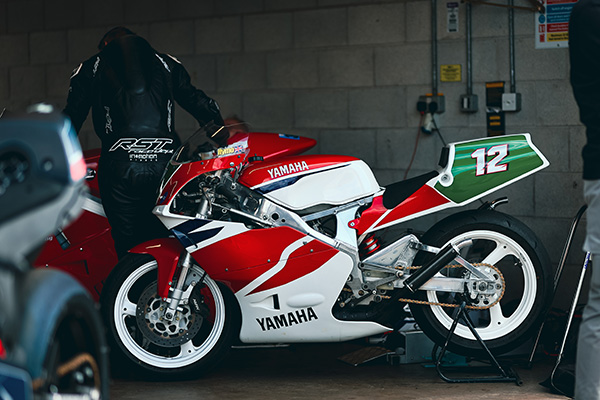21 February 205
There's a lot of classic Japanese racing motorcycles coming up for auction in 2025 - notably kicking off at Iconic Auctioneers' February 16 event at the London Motorcycle Show. Iain Macauley, automotive journalist, explores the topic further.
Classic racers from the heyday of Japanese racing superiority from the 1970s, '80s and '90s will feature at the auction as a substantial and important collection of Yamaha race machines go under the hammer with guide prices of between £4,000 and £40,000.
![]()
Courtesy Iconic Auctioneers
But just what do you do with a fickle two-stroke race bike of anything between 125cc and 750cc?

Courtesy Classic Bike Trackdays
You ride it. Not on the road, of course, but on track days, or even think about getting into club racing. You can store or display them if they're unused and original - that's where the value lies. But with anything classic or vintage, it's far better for them to be ridden.
But those of us of a certain age remember the reputation of some of those machines. While British race bikes were notorious for spreading engine oil in their wake, Japanese race bikes were prone to sudden engine seizures and consequently throwing their riders over the bars...
... although that's actually perhaps unfair: those engine seizures were often down to the fine line between tuning for power and speed, and tuning for reliability. And race riders being race riders, there was only one option to consider: speed.
Yamaha TZs were actually incredibly resilient and reliable if mechanics and riders didn't get too ambitious. A bike in standard tune would be very unlikely to spit you off - and it would give you plenty of warning anyway - but fuels and lubricants today are far higher quality, and provide the performance without compromising the reliability.

Courtesy Classic Bike Trackdays
The temptation is to buy something big, a 500 or 750, but those big two strokes were pretty ferocious beasts. By today's standards they're not particularly powerful, but they're light, and the way they deliver their power - suddenly, and with a big bang - made them far more difficult to ride fast than today's machines.
They're a bit clumsy in hairpins and getting away from a standstill, because gearing was high, so slipping the clutch and keeping it in the powerband to avoid stalling was a fine balance. Just keep the motor singing in the middle of the powerband and they're great fun.
Darin Frow of Classic Bike Track Days says they allow pre-2000 race bikes on to their events."We get them from the '60s, '70s, '80s - even the 1920s. It's '80s and '90s bikes we see most of - all sorts of makes. Some of the riders sometimes look to be as old as some of the older bikes.
"We break down our events to different capabilities and classes of rider - novice to highly experienced - and sometimes by bike type if there's enough of one particular category."
He says preparing for a classic bike track day warrants a bit of planning, for instance you'll need to ensure an early unsilenced two stroke - which at full revs could probably crack glass at 200 yards - falls within noise limits for the circuit at which you're riding.

Courtesy Classic Bike Trackdays
But these are old bikes: they'll often need recommissioning - and don't be tempted to keep them too original when it comes to consumables. Forty-year-old brake pads and tyres will have taken on either the consistency of wood, or the fragility of cream crackers.
Bikes, says Darin, need to be in good condition and with absolutely no sign of any fluid leaks. Tyres in good condition are crucial. Some, he says, do occasionally "go pop", and while that means a track closure and clean-up he says that's just part of life with a classic race bike.

Courtesy Classic Bike Trackdays
"Yamaha TZ250s and 350s are the most popular classic race bikes at our track days. There's loads of them around, and they're pretty reliable, although we do get the occasional TZ750. Some people turn up with several bikes. You don't have to spend £40,000 on your classic racer to have a great time," he says.
"Rarer bikes do turn up, but their riders and owners are cautious - sometimes parts are simply not available."
And unless the engine has been recently rebuilt or refurbished, get a specialist to give it the once over. Don't forget that old fuel can turn to jelly, both clogging fuel systems and rotting decades-old specification rubber and plastics.
As is the case with all bike track days stunts like wheelies and powerslides are black flag offences, although the transition of no power to full power in the space of a couple of millimetres of tachometer needle movement on a two-stroke can find you suddenly getting whacked in the chin by your fuel cap.
And both the power delivery and low-mounted handlebars can mean your wrists take a real hammering if you're used to a day-to-day classic steed with flat or high bars.
But a common comment is that a classic bike on a track day can be the most fun you can have with your leathers on.

Courtesy Classic Bike Trackdays

COMMENT